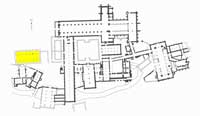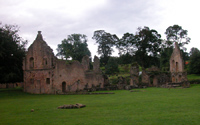 |
 |
 |
 |
 |
 |
 |
|
Fountains Abbey: History
Fountains Abbey: Buildings
|
Hospitality was an integral part of monastic
life and Fountains, like other Cistercian houses, made provision
for guests within the precinct. The twelfth-century guest complex
at Fountains is one of the most important in the country and sheds
considerable light on the facilities for and distinction of guests.
It comprised of two guest houses to accommodate distinguished visitors,
and a large aisled guest-hall for those of lesser note. The complex
lay to the west of the lay-brothers’ range,
which would have ensured that visitors caused minimum disruption
to the monks in
the cloister. Guests would have slept and dined in the guest complex,
under the auspices of the monastic official (obedientiary)
known as the guestmaster or
hosteller. He would have been assisted by at least one servant;
in the mid-fifteenth century Thomas Taylor
is named as the servant here.(102) Women
would not have been entertained in the guest complex, for Cistercian
legislation prohibited them
from staying within the abbey precinct. Some kind of provision
may have been made for them outside the West Gate, where there
was a hospice of sorts certainly in the sixteenth century.(103) Visiting Cistercians were regarded as part of the wider family, rather than outsiders, and as such were accommodated within the claustral area. They would have slept in the monks’ dormitory or an adjoining chamber, and dined with the community in the refectory. Cistercian prelates may have stayed with the abbot or in the infirmary complex.
|

